Today a small revolution: My guide came without car and just walked me the 5 minutes to the first temple. But later they could not resist driving me to the Potala Palace, although even that would have been just a 20 minute walk that I have done earlier and afterwards again. Potala Palace…that’s the impressive World Cultural Heritage everybody pictures first when hearing “Lhasa” or “Tibet”. Access to the Potala Palace is nowadyas highly organized with a limit of 800 visitors per day. My guide called me yesterday evening only to tell me the time of our visit as that was not confirmed earlier: 13:00, fairly inconvenient with regards to lunch.
Jokhang Temple
This is the temple right in the very center of the old city, that I had circled once already. Today we also visited it.
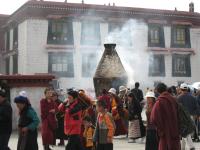
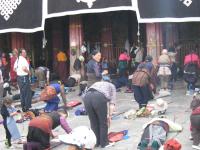
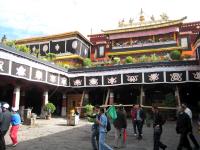
LS_20070624_095918.jpg: In front of the temple there is a lot of incense burning in two of these urns.
LS_20070624_100100.jpg: Right behind, in front of the main temple entrance, worshippers pray. I still fell like intercepting a ceremony when standing there and taking pictures like all the other tourists, huge Chinese tourist groups amongst them. And the lady in the middle…doesn’t she look right at me and angrily?
LS_20070624_101037.jpg: The temple was quite full and larger groups where at that time rejected. But with some friendly asking of my guide the two of us could enter. She, as a local, has actually very many contacts around and keeps greeting guards and guides all over the monasteries and temples. The Chinese guides had a lot more trouble getting through. The entrance ticket for no less than 70 RMB is actually a small CD-ROM. It didn’t start right away in my computer, but I found ways to look at the HTML pages: It offers some nice inside pictures together with explanatory texts, but lacks a bit the possibilities of the medium.
Eh…the picture: The inner yard of the temple.
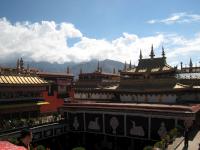
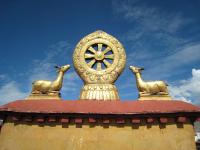
LS_20070624_105319.jpg: Once more taking photos was prohibit inside the temple. I did some secret hip shots, but they are all blurred beyond good. It is simply too dark in all these rooms. They never get daylight and in former times have been illuminated by butter lamps only. Nowadays there’s eletrical light, but t is still very dark. This picture is obviously taken outside again on the gallery surrounding the temple. It also offers good sights on the Potala Palace, but of that I later have better pictures. So here we see the same court yard once more from the top with the surrounding mountains in the back.
LS_20070624_105559.jpg: My guide tried to tell me the significance of this sculpture, but I couldn’t quite follow. Also the CD-ROM doesn’t mention it. So we have to enjoy this picture just because of its beauty.
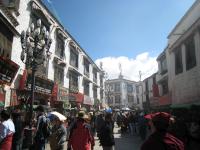
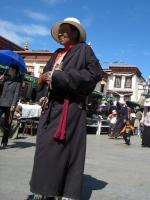
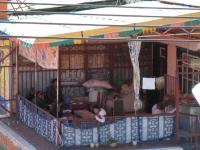
LS_20070624_110534.jpg: The circle street surrounding the temple, nowadays lined with souvenir booths. I even “had” to enter one of these typical souvenier shops in support for the tour organization, for which the guide apologized several times. Well…I took the chance of a forced visit to buy postcards, but certainly refrained from buying all the other kitsch, like paintings, pictures, buddhas in all shapes and sizes.
LS_20070624_110841.jpg: A tibetian worshipper on the way.
LS_20070624_114724.jpg: We were a bit too early for heading on to the Potala Palace right away, but also too early for lunch. So we just sat down for another Sweet Tea in the very same place I have been on my first evening, overlooking the square in front of Jokhang Temple. From there a view across the street down on a balcony that I had considered private, but later saw that some few people were actually getting up and down for a tea or so.
Potala Palace
Every ticket not only has a time of visit but also the visitor’s name. And that name is verified when entering by showing one’s passport! Before going through the nowaday’s unavoidable security check. They even collect all lighters! 😉 I was so wise to leave my bag in the car, only taking the camera, the passport, and a water bottle with me.
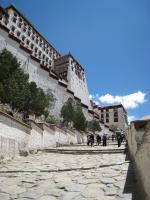
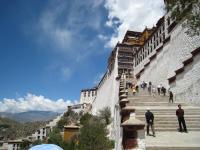
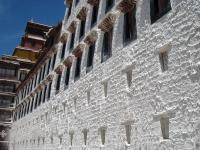
LS_20070624_124422.jpg: The way uphill on one of the stairways you clearly see on front pictures of the palace going diagonally across the white front wall.
LS_20070624_124706.jpg: A bit better to sense from this picture.
LS_20070624_125410.jpg: The rough white walls throwing shadows in today’s bright sunlight. We could not look into the small chambers behind these windows. The palace is known to literally have 1,000 rooms, of which we saw probably 15 or 20 only.
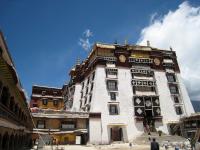
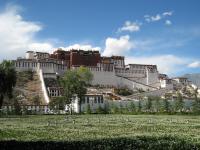
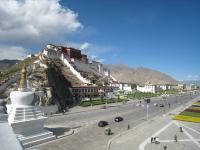
LS_20070624_130040.jpg: The last picture allowed, as far as possible “inside” the palace. We are actually standing in a court yard on about the 9th floor. We then entered through the door in the lower-right corner of the picture into the white palace and later over the usual steep stairways also briefly into the red palace. I am wondering how many accidents they have in the many monasteries and temples with regards to these extremely steep stairways. Some old people had really difficulties getting down again…but no matter if there is enough room or not, stairs are always extremely steep.
After entering the above mentioned door we had exactly one hour time. And the time was taken! My guide registered us at exactly 13:04. And when we finally left the inner part she had to present that piece of paper at another official with a digital clock, who noted down the exit time, 13:51, signed by both. So we spent exactly 47 minutes inside, with my guide constantly watching the watch. Now you know why a watch is called a watch… Although I certainly asked I could not figure out what would happen if you exceed the time…probably just a monetary fine.
On the way up I jokingly asked what they would do with this tourist hot spot if the Dalai Lama returns and claims his residence for him. But she only answered I should better refrain from asking political questions, especially later inside the palace as there were Chinese officials all around understanding English. But she hurriedly added that all Tibetians certainly hope for the Dalai Lama to return.
The inside was indeed great and not comparable to the monasteries. Sure, there was another collection of statues of buddhas and lamas. But what sticks to your mind is the large assemply hall, which due to a small window even catched sunlight, which made it a lot more pleasant. And all the tomb stupas of the previous Dalai Lamas, all of them burried within this palace starting from the 5. Dalai Lama. The stupas varied in size with the one of the 5. Dalai Lama being the largest as he was most important to spreading Buddhism in Tibet. He was also the one to extend the Potala Palace to its today’s size. The palace was apparently built in two phases, the first one being about the red parts (called “Red Palace” for obvious reasons), originally built by a Tibetian king. The white parts where then later added by the 5. Dalai Lama. It is also amazing how all the levels and rooms are interconnected…we switched floors after every corner up or down…I lost completely track of the floor number. In total the palace has 14 floors. Somewhere we also saw the Dalai Lama’s residential quarters with study, living room and the like.
In the end you actually get out on the back side of the palace. As I wrote earlier the palace sits on top of a hill and also on the back extends a bit downhill, pretty similar to its well-known front. However, the “landscape” on the back side is no longer interesting. It used to be wetlands, but with Chinese governmental construction of the square in front (see yesterday) it had moved all houses formerly there to the back, drying the wet lands. And there is now just a “modern” Chinese residential area with thousands of 2-storey uninteresting houses.
LS_20070624_171726.jpg: After lunch and a break I returned on my own back to the Potala square. After a brief rain shower it had cleared up again for some final full shots of the entire palace.
LS_20070624_173008.jpg: Here a view as far side-ways as reasonably possible, showing that the palace sits atop a hill, extending also down its back.
Today’s Lesson: A watch is called a watch, because you need to constantly watch it in order not to exceed Potala Palace’s 60 minute time limit.
Categories: Asia, Lhasa
Originally Created: 06/24/2007 01:28:30 PM
Last Edited: 06/24/2007